Analyzing Contemporary and Future Policies in Indigenous Education
VerifiedAdded on 2021/08/30
|5
|1566
|233
Essay
AI Summary
This essay critically examines contemporary and future policy directions and initiatives in Aboriginal and Torres Strait Islander education, employing equity and social justice lenses. The author emphasizes the importance of prioritizing Indigenous languages, incorporating non-verbal communication methods, and utilizing full sentences in language instruction. The essay advocates for integrating cultural elements into the educational process, fostering a sense of belonging, and promoting the cultural identity of Aboriginal and Torres Strait Islander students. It also highlights current benefits such as early education programs, efforts to reduce the education gap, and increased opportunities for higher education and employment. The essay suggests strategies to build and embed the Aboriginal culture, including improving cultural understanding, utilizing visual communication, providing effective feedback, and organizing cultural events. The essay references several studies to support its arguments and emphasizes the importance of collaboration between government and private sectors, community engagement, and awareness campaigns to improve Indigenous education in Australia.
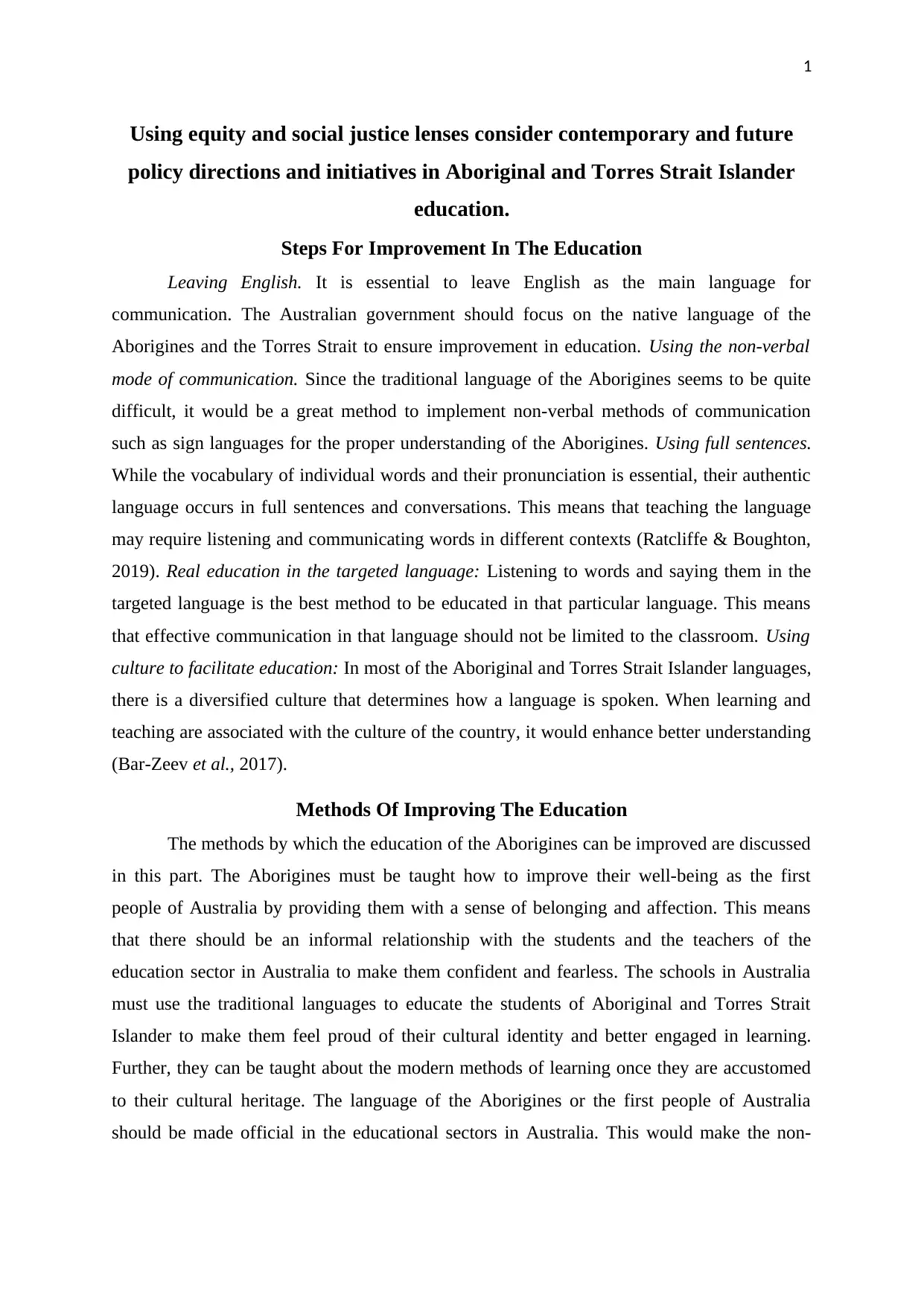
1
Using equity and social justice lenses consider contemporary and future
policy directions and initiatives in Aboriginal and Torres Strait Islander
education.
Steps For Improvement In The Education
Leaving English. It is essential to leave English as the main language for
communication. The Australian government should focus on the native language of the
Aborigines and the Torres Strait to ensure improvement in education. Using the non-verbal
mode of communication. Since the traditional language of the Aborigines seems to be quite
difficult, it would be a great method to implement non-verbal methods of communication
such as sign languages for the proper understanding of the Aborigines. Using full sentences.
While the vocabulary of individual words and their pronunciation is essential, their authentic
language occurs in full sentences and conversations. This means that teaching the language
may require listening and communicating words in different contexts (Ratcliffe & Boughton,
2019). Real education in the targeted language: Listening to words and saying them in the
targeted language is the best method to be educated in that particular language. This means
that effective communication in that language should not be limited to the classroom. Using
culture to facilitate education: In most of the Aboriginal and Torres Strait Islander languages,
there is a diversified culture that determines how a language is spoken. When learning and
teaching are associated with the culture of the country, it would enhance better understanding
(Bar-Zeev et al., 2017).
Methods Of Improving The Education
The methods by which the education of the Aborigines can be improved are discussed
in this part. The Aborigines must be taught how to improve their well-being as the first
people of Australia by providing them with a sense of belonging and affection. This means
that there should be an informal relationship with the students and the teachers of the
education sector in Australia to make them confident and fearless. The schools in Australia
must use the traditional languages to educate the students of Aboriginal and Torres Strait
Islander to make them feel proud of their cultural identity and better engaged in learning.
Further, they can be taught about the modern methods of learning once they are accustomed
to their cultural heritage. The language of the Aborigines or the first people of Australia
should be made official in the educational sectors in Australia. This would make the non-
Using equity and social justice lenses consider contemporary and future
policy directions and initiatives in Aboriginal and Torres Strait Islander
education.
Steps For Improvement In The Education
Leaving English. It is essential to leave English as the main language for
communication. The Australian government should focus on the native language of the
Aborigines and the Torres Strait to ensure improvement in education. Using the non-verbal
mode of communication. Since the traditional language of the Aborigines seems to be quite
difficult, it would be a great method to implement non-verbal methods of communication
such as sign languages for the proper understanding of the Aborigines. Using full sentences.
While the vocabulary of individual words and their pronunciation is essential, their authentic
language occurs in full sentences and conversations. This means that teaching the language
may require listening and communicating words in different contexts (Ratcliffe & Boughton,
2019). Real education in the targeted language: Listening to words and saying them in the
targeted language is the best method to be educated in that particular language. This means
that effective communication in that language should not be limited to the classroom. Using
culture to facilitate education: In most of the Aboriginal and Torres Strait Islander languages,
there is a diversified culture that determines how a language is spoken. When learning and
teaching are associated with the culture of the country, it would enhance better understanding
(Bar-Zeev et al., 2017).
Methods Of Improving The Education
The methods by which the education of the Aborigines can be improved are discussed
in this part. The Aborigines must be taught how to improve their well-being as the first
people of Australia by providing them with a sense of belonging and affection. This means
that there should be an informal relationship with the students and the teachers of the
education sector in Australia to make them confident and fearless. The schools in Australia
must use the traditional languages to educate the students of Aboriginal and Torres Strait
Islander to make them feel proud of their cultural identity and better engaged in learning.
Further, they can be taught about the modern methods of learning once they are accustomed
to their cultural heritage. The language of the Aborigines or the first people of Australia
should be made official in the educational sectors in Australia. This would make the non-
Paraphrase This Document
Need a fresh take? Get an instant paraphrase of this document with our AI Paraphraser
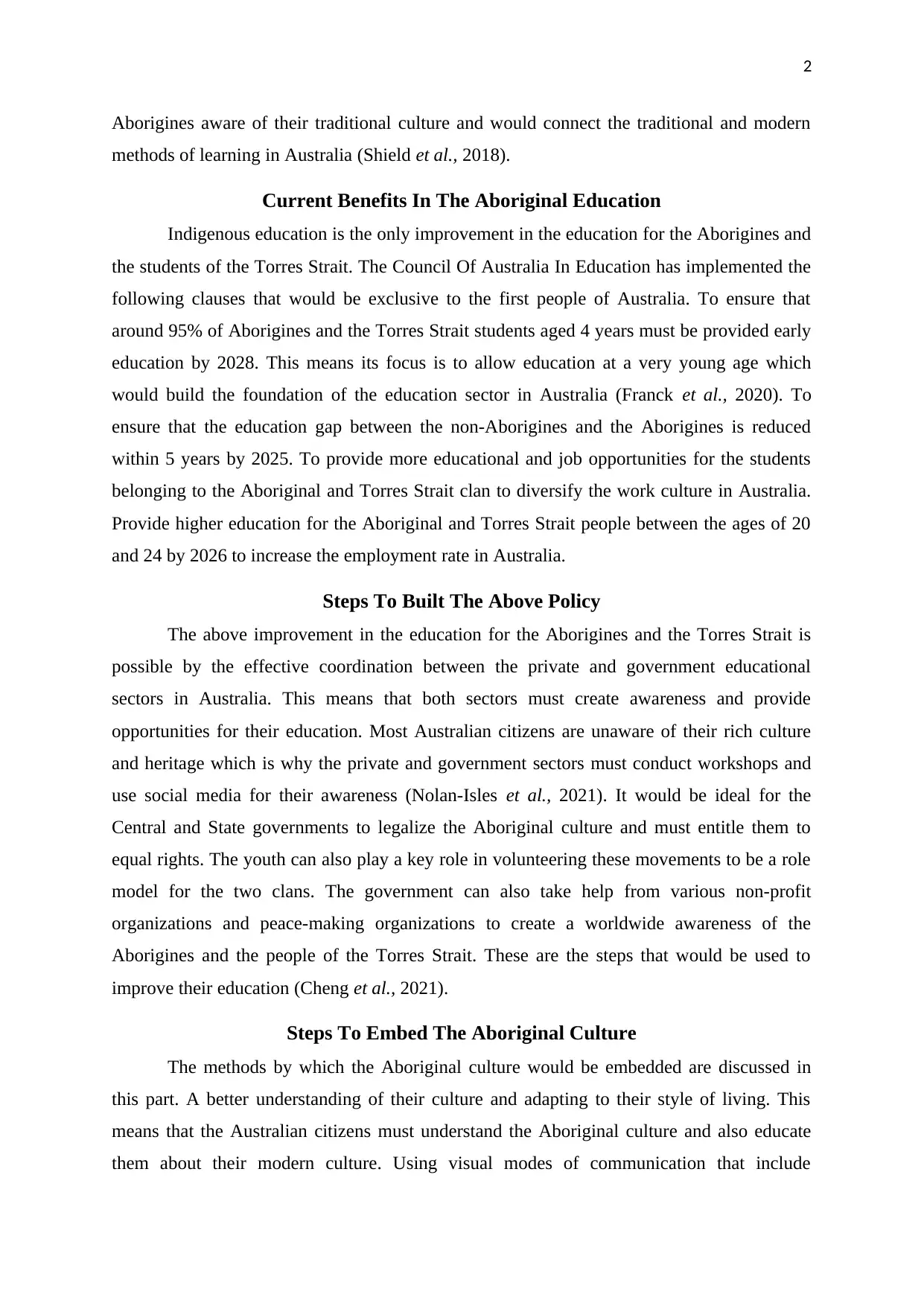
2
Aborigines aware of their traditional culture and would connect the traditional and modern
methods of learning in Australia (Shield et al., 2018).
Current Benefits In The Aboriginal Education
Indigenous education is the only improvement in the education for the Aborigines and
the students of the Torres Strait. The Council Of Australia In Education has implemented the
following clauses that would be exclusive to the first people of Australia. To ensure that
around 95% of Aborigines and the Torres Strait students aged 4 years must be provided early
education by 2028. This means its focus is to allow education at a very young age which
would build the foundation of the education sector in Australia (Franck et al., 2020). To
ensure that the education gap between the non-Aborigines and the Aborigines is reduced
within 5 years by 2025. To provide more educational and job opportunities for the students
belonging to the Aboriginal and Torres Strait clan to diversify the work culture in Australia.
Provide higher education for the Aboriginal and Torres Strait people between the ages of 20
and 24 by 2026 to increase the employment rate in Australia.
Steps To Built The Above Policy
The above improvement in the education for the Aborigines and the Torres Strait is
possible by the effective coordination between the private and government educational
sectors in Australia. This means that both sectors must create awareness and provide
opportunities for their education. Most Australian citizens are unaware of their rich culture
and heritage which is why the private and government sectors must conduct workshops and
use social media for their awareness (Nolan-Isles et al., 2021). It would be ideal for the
Central and State governments to legalize the Aboriginal culture and must entitle them to
equal rights. The youth can also play a key role in volunteering these movements to be a role
model for the two clans. The government can also take help from various non-profit
organizations and peace-making organizations to create a worldwide awareness of the
Aborigines and the people of the Torres Strait. These are the steps that would be used to
improve their education (Cheng et al., 2021).
Steps To Embed The Aboriginal Culture
The methods by which the Aboriginal culture would be embedded are discussed in
this part. A better understanding of their culture and adapting to their style of living. This
means that the Australian citizens must understand the Aboriginal culture and also educate
them about their modern culture. Using visual modes of communication that include
Aborigines aware of their traditional culture and would connect the traditional and modern
methods of learning in Australia (Shield et al., 2018).
Current Benefits In The Aboriginal Education
Indigenous education is the only improvement in the education for the Aborigines and
the students of the Torres Strait. The Council Of Australia In Education has implemented the
following clauses that would be exclusive to the first people of Australia. To ensure that
around 95% of Aborigines and the Torres Strait students aged 4 years must be provided early
education by 2028. This means its focus is to allow education at a very young age which
would build the foundation of the education sector in Australia (Franck et al., 2020). To
ensure that the education gap between the non-Aborigines and the Aborigines is reduced
within 5 years by 2025. To provide more educational and job opportunities for the students
belonging to the Aboriginal and Torres Strait clan to diversify the work culture in Australia.
Provide higher education for the Aboriginal and Torres Strait people between the ages of 20
and 24 by 2026 to increase the employment rate in Australia.
Steps To Built The Above Policy
The above improvement in the education for the Aborigines and the Torres Strait is
possible by the effective coordination between the private and government educational
sectors in Australia. This means that both sectors must create awareness and provide
opportunities for their education. Most Australian citizens are unaware of their rich culture
and heritage which is why the private and government sectors must conduct workshops and
use social media for their awareness (Nolan-Isles et al., 2021). It would be ideal for the
Central and State governments to legalize the Aboriginal culture and must entitle them to
equal rights. The youth can also play a key role in volunteering these movements to be a role
model for the two clans. The government can also take help from various non-profit
organizations and peace-making organizations to create a worldwide awareness of the
Aborigines and the people of the Torres Strait. These are the steps that would be used to
improve their education (Cheng et al., 2021).
Steps To Embed The Aboriginal Culture
The methods by which the Aboriginal culture would be embedded are discussed in
this part. A better understanding of their culture and adapting to their style of living. This
means that the Australian citizens must understand the Aboriginal culture and also educate
them about their modern culture. Using visual modes of communication that include
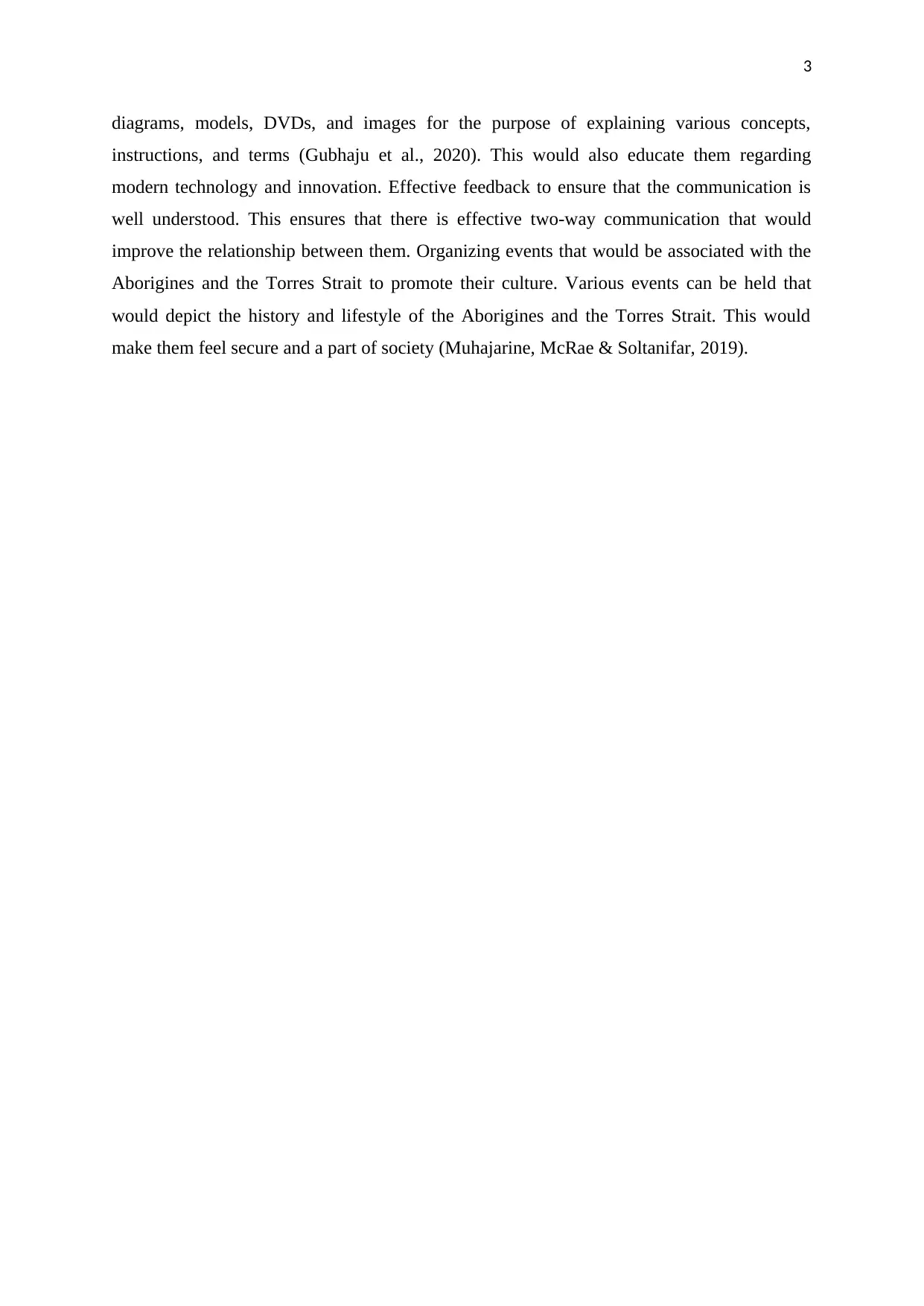
3
diagrams, models, DVDs, and images for the purpose of explaining various concepts,
instructions, and terms (Gubhaju et al., 2020). This would also educate them regarding
modern technology and innovation. Effective feedback to ensure that the communication is
well understood. This ensures that there is effective two-way communication that would
improve the relationship between them. Organizing events that would be associated with the
Aborigines and the Torres Strait to promote their culture. Various events can be held that
would depict the history and lifestyle of the Aborigines and the Torres Strait. This would
make them feel secure and a part of society (Muhajarine, McRae & Soltanifar, 2019).
diagrams, models, DVDs, and images for the purpose of explaining various concepts,
instructions, and terms (Gubhaju et al., 2020). This would also educate them regarding
modern technology and innovation. Effective feedback to ensure that the communication is
well understood. This ensures that there is effective two-way communication that would
improve the relationship between them. Organizing events that would be associated with the
Aborigines and the Torres Strait to promote their culture. Various events can be held that
would depict the history and lifestyle of the Aborigines and the Torres Strait. This would
make them feel secure and a part of society (Muhajarine, McRae & Soltanifar, 2019).
⊘ This is a preview!⊘
Do you want full access?
Subscribe today to unlock all pages.

Trusted by 1+ million students worldwide
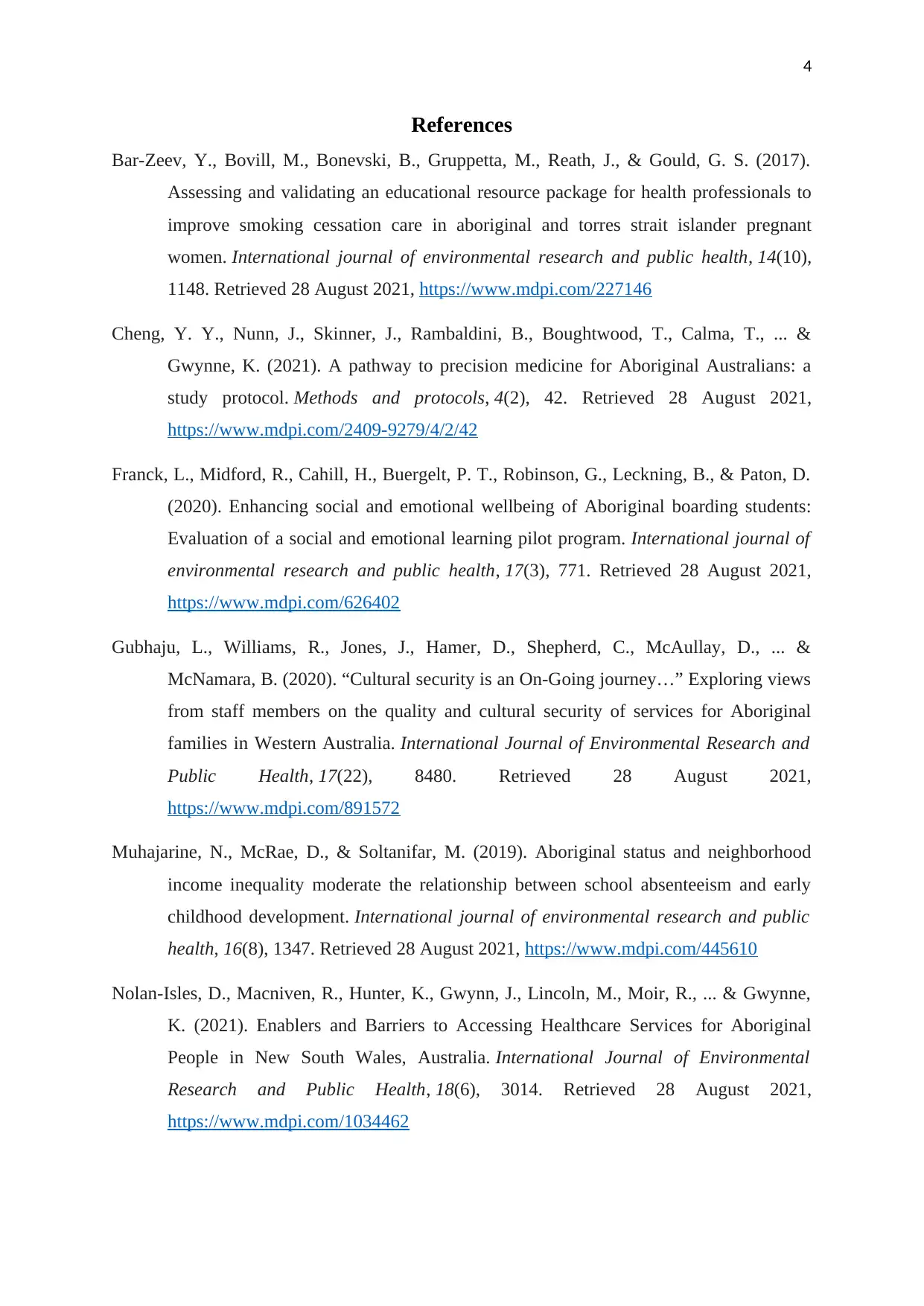
4
References
Bar-Zeev, Y., Bovill, M., Bonevski, B., Gruppetta, M., Reath, J., & Gould, G. S. (2017).
Assessing and validating an educational resource package for health professionals to
improve smoking cessation care in aboriginal and torres strait islander pregnant
women. International journal of environmental research and public health, 14(10),
1148. Retrieved 28 August 2021, https://www.mdpi.com/227146
Cheng, Y. Y., Nunn, J., Skinner, J., Rambaldini, B., Boughtwood, T., Calma, T., ... &
Gwynne, K. (2021). A pathway to precision medicine for Aboriginal Australians: a
study protocol. Methods and protocols, 4(2), 42. Retrieved 28 August 2021,
https://www.mdpi.com/2409-9279/4/2/42
Franck, L., Midford, R., Cahill, H., Buergelt, P. T., Robinson, G., Leckning, B., & Paton, D.
(2020). Enhancing social and emotional wellbeing of Aboriginal boarding students:
Evaluation of a social and emotional learning pilot program. International journal of
environmental research and public health, 17(3), 771. Retrieved 28 August 2021,
https://www.mdpi.com/626402
Gubhaju, L., Williams, R., Jones, J., Hamer, D., Shepherd, C., McAullay, D., ... &
McNamara, B. (2020). “Cultural security is an On-Going journey…” Exploring views
from staff members on the quality and cultural security of services for Aboriginal
families in Western Australia. International Journal of Environmental Research and
Public Health, 17(22), 8480. Retrieved 28 August 2021,
https://www.mdpi.com/891572
Muhajarine, N., McRae, D., & Soltanifar, M. (2019). Aboriginal status and neighborhood
income inequality moderate the relationship between school absenteeism and early
childhood development. International journal of environmental research and public
health, 16(8), 1347. Retrieved 28 August 2021, https://www.mdpi.com/445610
Nolan-Isles, D., Macniven, R., Hunter, K., Gwynn, J., Lincoln, M., Moir, R., ... & Gwynne,
K. (2021). Enablers and Barriers to Accessing Healthcare Services for Aboriginal
People in New South Wales, Australia. International Journal of Environmental
Research and Public Health, 18(6), 3014. Retrieved 28 August 2021,
https://www.mdpi.com/1034462
References
Bar-Zeev, Y., Bovill, M., Bonevski, B., Gruppetta, M., Reath, J., & Gould, G. S. (2017).
Assessing and validating an educational resource package for health professionals to
improve smoking cessation care in aboriginal and torres strait islander pregnant
women. International journal of environmental research and public health, 14(10),
1148. Retrieved 28 August 2021, https://www.mdpi.com/227146
Cheng, Y. Y., Nunn, J., Skinner, J., Rambaldini, B., Boughtwood, T., Calma, T., ... &
Gwynne, K. (2021). A pathway to precision medicine for Aboriginal Australians: a
study protocol. Methods and protocols, 4(2), 42. Retrieved 28 August 2021,
https://www.mdpi.com/2409-9279/4/2/42
Franck, L., Midford, R., Cahill, H., Buergelt, P. T., Robinson, G., Leckning, B., & Paton, D.
(2020). Enhancing social and emotional wellbeing of Aboriginal boarding students:
Evaluation of a social and emotional learning pilot program. International journal of
environmental research and public health, 17(3), 771. Retrieved 28 August 2021,
https://www.mdpi.com/626402
Gubhaju, L., Williams, R., Jones, J., Hamer, D., Shepherd, C., McAullay, D., ... &
McNamara, B. (2020). “Cultural security is an On-Going journey…” Exploring views
from staff members on the quality and cultural security of services for Aboriginal
families in Western Australia. International Journal of Environmental Research and
Public Health, 17(22), 8480. Retrieved 28 August 2021,
https://www.mdpi.com/891572
Muhajarine, N., McRae, D., & Soltanifar, M. (2019). Aboriginal status and neighborhood
income inequality moderate the relationship between school absenteeism and early
childhood development. International journal of environmental research and public
health, 16(8), 1347. Retrieved 28 August 2021, https://www.mdpi.com/445610
Nolan-Isles, D., Macniven, R., Hunter, K., Gwynn, J., Lincoln, M., Moir, R., ... & Gwynne,
K. (2021). Enablers and Barriers to Accessing Healthcare Services for Aboriginal
People in New South Wales, Australia. International Journal of Environmental
Research and Public Health, 18(6), 3014. Retrieved 28 August 2021,
https://www.mdpi.com/1034462
Paraphrase This Document
Need a fresh take? Get an instant paraphrase of this document with our AI Paraphraser
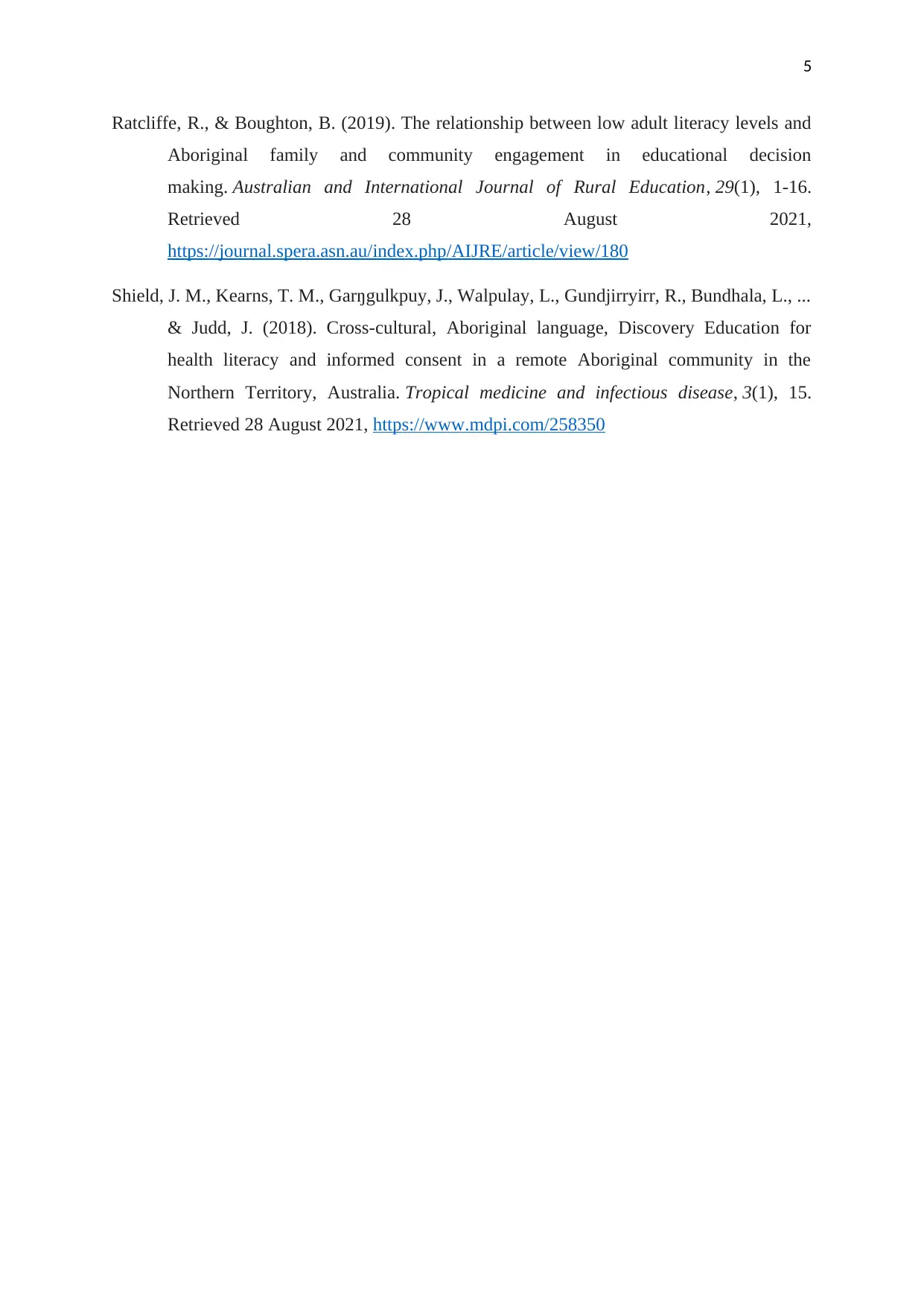
5
Ratcliffe, R., & Boughton, B. (2019). The relationship between low adult literacy levels and
Aboriginal family and community engagement in educational decision
making. Australian and International Journal of Rural Education, 29(1), 1-16.
Retrieved 28 August 2021,
https://journal.spera.asn.au/index.php/AIJRE/article/view/180
Shield, J. M., Kearns, T. M., Garŋgulkpuy, J., Walpulay, L., Gundjirryirr, R., Bundhala, L., ...
& Judd, J. (2018). Cross-cultural, Aboriginal language, Discovery Education for
health literacy and informed consent in a remote Aboriginal community in the
Northern Territory, Australia. Tropical medicine and infectious disease, 3(1), 15.
Retrieved 28 August 2021, https://www.mdpi.com/258350
Ratcliffe, R., & Boughton, B. (2019). The relationship between low adult literacy levels and
Aboriginal family and community engagement in educational decision
making. Australian and International Journal of Rural Education, 29(1), 1-16.
Retrieved 28 August 2021,
https://journal.spera.asn.au/index.php/AIJRE/article/view/180
Shield, J. M., Kearns, T. M., Garŋgulkpuy, J., Walpulay, L., Gundjirryirr, R., Bundhala, L., ...
& Judd, J. (2018). Cross-cultural, Aboriginal language, Discovery Education for
health literacy and informed consent in a remote Aboriginal community in the
Northern Territory, Australia. Tropical medicine and infectious disease, 3(1), 15.
Retrieved 28 August 2021, https://www.mdpi.com/258350
1 out of 5
Related Documents
Your All-in-One AI-Powered Toolkit for Academic Success.
+13062052269
info@desklib.com
Available 24*7 on WhatsApp / Email
![[object Object]](/_next/static/media/star-bottom.7253800d.svg)
Unlock your academic potential
Copyright © 2020–2025 A2Z Services. All Rights Reserved. Developed and managed by ZUCOL.




